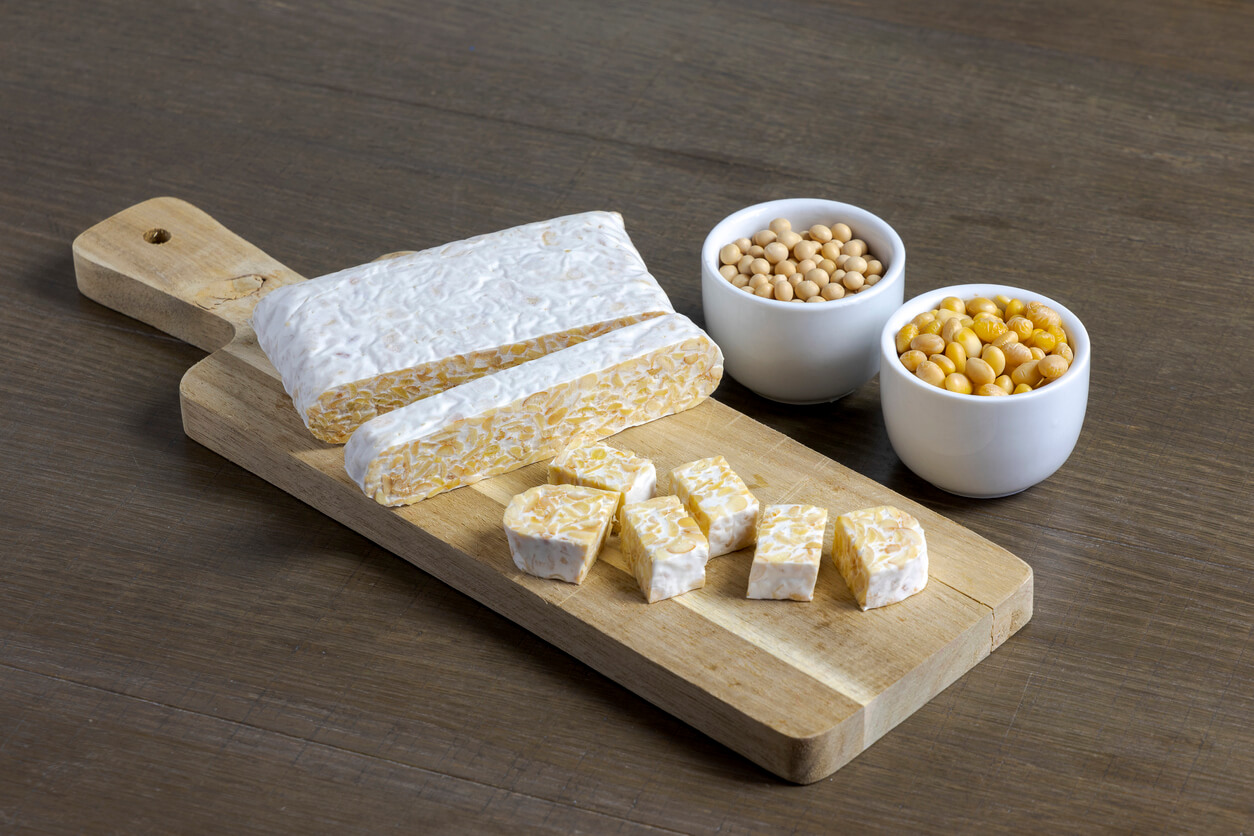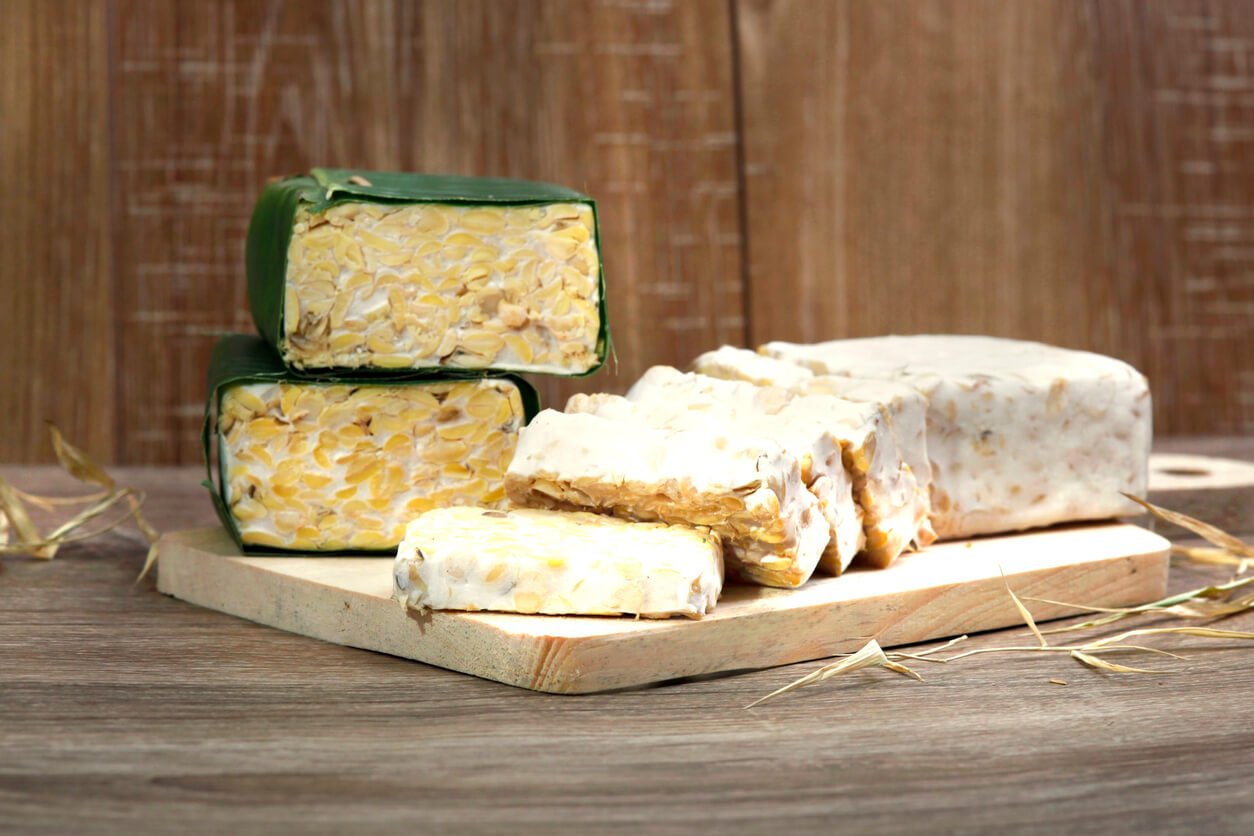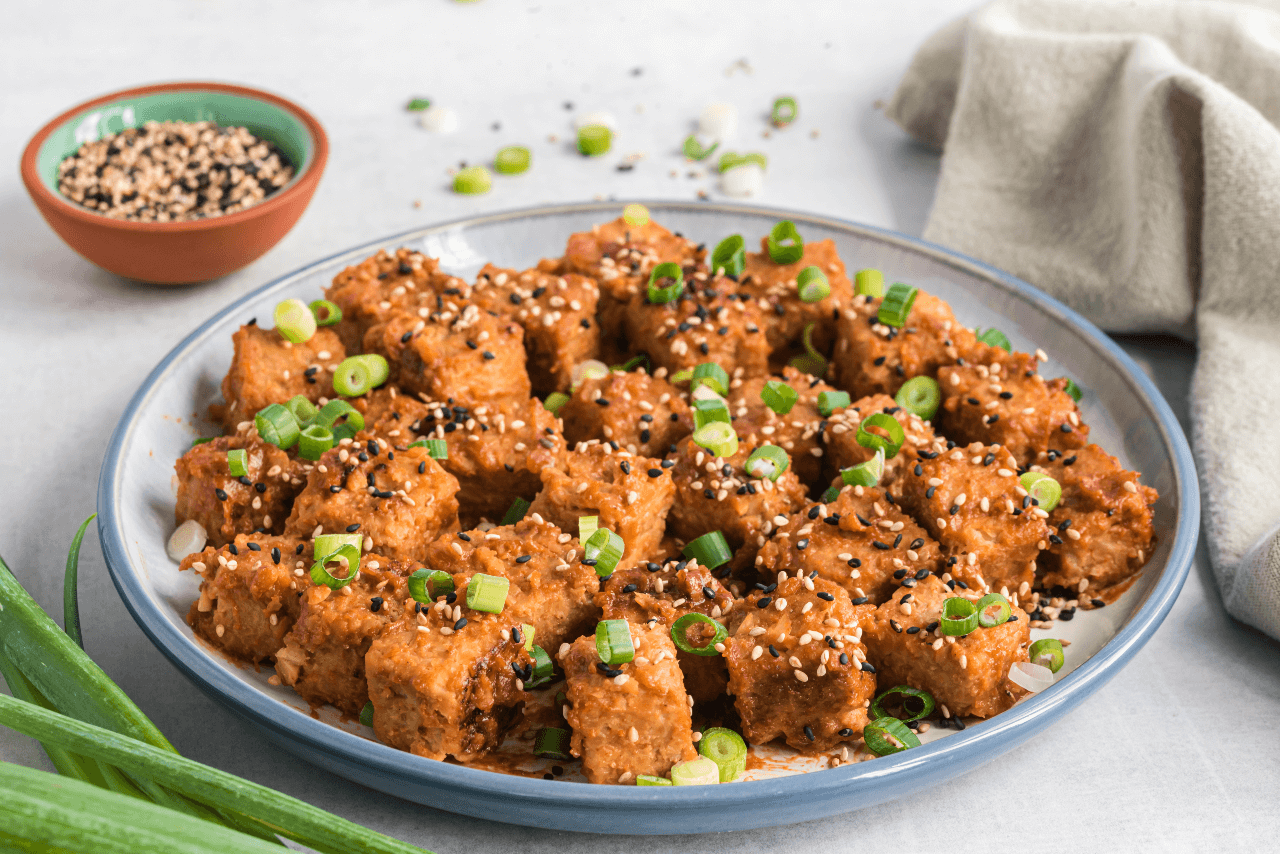You may be familiar with tofu, but have you made friends with its fermented relative, tempeh? Perhaps you’ve seen a tempeh block in a store but don’t know what it is or how to cook it. Maybe you bought it, cubed it in a stir-fry, and found it a “more acquired taste,” shall we say, than the culinary chameleon tofu.
Perhaps you’ve tasted tempeh in a restaurant and are wondering how to make it at home, so it’s just as yummy. Or maybe you’re just curious to try a meat alternative that’s highly nutritious, less processed than tofu, and extremely versatile.
In this article, you’ll discover tempeh, learn why it’s really good for you, and find out how to use it in your diet. And you’ll be rewarded with some mouth-watering tempeh recipes to get you started enjoying this fabulous, fermented food.
What Is Tempeh?

Tempeh is a fermented bean cake, patty, or block. It’s made by partially cooking the beans and then fermenting them with a mold called Rhizopus oligosporus. Soybeans are the most typical legume found in tempeh, but other kinds of beans can be used to make it as well. Tempeh makers sometimes also include grains like rice, barley, and millet in their cakes. And some even make Hempeh, which, not surprisingly, features hemp seeds.
Because of the beans that are typically its centerpiece, tempeh is a high protein food, and can act as a plant-based alternative to meat. Depending on how you prepare it, tempeh can have a “meaty” texture, as it’s naturally chewier and denser than tofu, or it can take on a crispy texture like bacon.
Tempeh probably originated in Java (Indonesia) several centuries ago (the earliest known written reference to “têmpê” dates back to 1815, but many historians believe it was invented long before then).
Healthy Fungus
The first tempeh makers took the soybeans off the stove (or fire, as the case may be) before they fully cooked, and then wrapped them in hibiscus leaves to cool. Left out overnight in a tropical climate, the beans served as a friendly growth medium for the rhizopus fungus, which grew first on the leaves, and then colonized the soybeans.
After a few days, the fungus had not only partially digested the soybeans, rendering them more edible and their nutrients more easily bioavailable, but had also formed a fibrous mold around them, turning them from a pile of beans into a solid block.
The rhizopus fungus had another trick up its sleeve: by colonizing the beans, it outcompeted harmful-to-human-health fungi such as Aspergillus flavus and Staphylococcus aureus. Tempeh cakes were, therefore, seen as a health-promoting fungus, and could be stored safely even in the absence of refrigeration.
Once Javanese cooks discovered all these wonderful properties of rhizopus, they set about domesticating it, so they could always have a reliable supply of the stuff. (“Sit, rhizopus. Stay… Good fungus!”)
Why Is Tempeh Good for You?

Tempeh scores remarkably high on the “awesomely-good-for-you” chart. Why? For one thing, it delivers a whopping 33 grams of plant-based protein per cup. And it’s naturally low in sodium, a good source of complex carbohydrates, and an excellent source of fiber. Plus, it combines the benefits of two of the healthiest foods on the planet: soy and fermented foods.
We know this thanks to Blue Zone research, which examines the diets and lifestyles of the longest-lived (and healthiest) peoples on earth. In one Blue Zone, Okinawa, soybeans are a staple food. And fermented foods feature prominently in many Blue Zone dishes, including sourdough bread, tofu, wine, and pickled vegetables.
Fermentation appears to have many health benefits. These include the ability to fight disease, strengthen bones, support gut health and immunity, and even help with weight management. And legumes, including soybeans, are high in not only protein, but also B vitamins, and tons of minerals, such as: calcium, iron, magnesium, phosphorus, potassium, copper, and manganese — minerals that fermentation may help to make more bioavailable.
Downsides of Tempeh

But all is not rainbows and unicorns in tempeh-land, however. Unfortunately, if you’re eating soybeans, you have to watch out for GMOs. Around 94% of the soybeans grown in the US are genetically engineered. And if you’re eating GMO soy, you’re almost certainly ingesting the herbicide glyphosate, which is an endocrine disruptor, may cause cancer in humans, and appears to wreak havoc on the all-important human microbiome. This is why it’s important to get tempeh that’s either organic or certified non-GMO.
Are there other downsides? For a small number of people, tempeh from soybeans may cause digestive discomfort or other problems. Since we are each biochemically and metabolically unique, there may be some people who have difficulties digesting tempeh, though that is rare. And to be clear, soy, in general, is not harmful — that’s a myth we’re called upon to debunk regularly (no, it doesn’t turn boys into girls; in fact, dairy appears to be the main dietary cause of male feminization, not soy milk). There’s no evidence that soy causes cancer; in fact, it may actually prevent and protect against the disease.
And while the research is murky, it seems that excess amounts of soy may modestly raise TSH (thyroid-stimulating hormone) levels in people who aren’t consuming adequate dietary iodine. As such, a very high-soy diet may not be advisable for those with an underactive thyroid (“hypothyroidism”) disorder.
Raw Tempeh
Finally, tempeh is not a dish you should eat raw, especially if you’re making your own or buying freshly-made cakes that haven’t gone through the pasteurization process. Even if you do get the pasteurized “ready-to-eat” varieties, it’s still best to cook your tempeh to avoid foodborne illness. As with most fermented foods, there may be a risk for bacterial contamination from mishandling.
Not that the need to cook tempeh is a big problem. Almost everyone prefers the taste of cooked tempeh to the raw versions. Not only can cooking add lots of yummy flavors (smoky, sweet, and umami are common ones), but cooking tempeh can reduce or eliminate a bitter undertone that some people find unpleasant in raw tempeh.
Where to Buy Tempeh & What to Look for

From its origins as an accidental Indonesian bean mold cake, tempeh and its rhizopus mycelium have become ubiquitous in natural foods stores — and even mainstream supermarkets. You can also find tempeh in Asian markets and online retailers.
In stores, tempeh usually comes in eight-ounce packages and is displayed in the refrigerated section — sometimes near the meat or meat alternatives. It comes in a long rectangular block and is typically double-wrapped in plastic.
But how can you tell if tempeh is fresh if it’s made with a fungus? If it’s in a package, use your eyes and hands. The exterior mold should be mostly white, without discoloration. The texture should be firm, not mushy, soft, sticky, or slimy. Once you get it home and open the package, smell it. Good tempeh has a yeasty or mushroom-like aroma. Any off-odors may mean that something else — a nasty bacteria, perhaps — has colonized the tempeh. If it smells bad, then it’s safe only for the compost pile.
How to Prepare & Use Tempeh

Tempeh is typically sliced, cut into cubes, or crumbled before cooking and using it in a recipe. When you slice tempeh, you get to choose the thickness, depending on what you’re making. For tempeh bacon, go thin. For recipes that mimic chicken or beef strips, or that involve stirring, go thicker, so the tempeh doesn’t fall apart.
You can cook tempeh in a variety of ways, including baking it in an oven, steaming it in a pot or steamer (you can do this as a preliminary step to eliminate that bitter taste some people find less than delicious), pan-fried on the stovetop, grilled, or fried in an air fryer.
Like tofu, tempeh is mild (some would say fairly flavorless) and will take on whatever flavors it’s seasoned or marinated in. But since tempeh is denser than tofu, it absorbs flavors less readily. You can compensate by pre-steaming or boiling it for 15 minutes (this method helps it to absorb flavors more readily), marinating it longer, or cutting it into smaller pieces. Use BBQ sauce, Buffalo sauce, a soy sauce-based marinade, or any other seasoning that strikes your fancy.
You can also use tempeh as a vegan alternative to bacon. Add spices and a marinade to impart that sweet, smoky, salty flavor, and slice it thin for optimal crispiness.
Tempeh bacon can replace oily and highly processed commercial croutons to add flavor and texture to your favorite salads. You can slice it, or crumble it into fake bacon bits. For that matter, marinated and baked or air-fried tempeh makes an awesome crispy snack all by itself.
You can also add cooked tempeh to salads, power bowls and grain bowls, stir-fries, vegan chili (crumbled, it makes a great ground meat substitute), and pasta dishes that traditionally call for meat.
Tempeh is a natural filling for sandwiches, too, and can work in both its crunchy and chewy incarnations. And when you’re feeling fancy and artistic, work some cubed or sliced tempeh into your next plant-based charcuterie board.
How to Make Tempeh
If you can get your hands on some tempeh starter culture, which comes in a plastic baggy and looks like white powder, you can make your own tempeh.
Why would you want to? First off, it’s fun — and if you have kids around, it can even make a good and wholesome science experiment. Second, making kitchen staples is really empowering, as it gives you some degree of independence from the industrial food system. And third, homemade tempeh can taste better than commercially available varieties since it’s fresher, and you can add other beans and grains according to your preferences.
You basically need just three ingredients to make tempeh: dried soybeans, vinegar, and tempeh starter culture. In terms of equipment, you’ll need a sieve, “meat” thermometer, (optional) pressure cooker, and either plastic bags, or stainless steel trays with the tops of the trays covered with perforated aluminum foil or parchment paper.
Here’s a simple process for making tempeh (I recommend using a tray with parchment paper over the top). If you have access to an Instant Pot, you can use this higher-tech method.
Visual learner? Here’s a video demonstration:
https://www.youtube.com/watch?v=aTJTNWutQkg
But after you’ve made your tempeh, or bought it from the store, what do you do with it? Here are five recipes to get you started.
5 Tantalizing Tempeh Recipes
Whether tempeh is a new experience for you, or it’s a plant-based staple on your plate, you’ll find a variety of recipes using tempeh to try below! Of course, we had to include Tempeh Bacon. Enjoy it as a snack, in a sandwich (TLT, anyone?) or on top of a salad.
Teriyaki lovers, the Grilled Teriyaki Tempeh is for you! And the Warm Tempeh and Kale Salad is refreshing enough to be a summer favorite while also being hearty enough to be relished in the winter.
Get an explosion of flavors, textures, and nutrition with the Blackened Tempeh and Sweet Potato with Avocado and Kale Bowl. And if you have picky eaters at home, the Champion Tempeh Chili is one to wow the whole family!
1. Tempeh Bacon

There are two tricks involved with optimizing Tempeh Bacon’s flavor: cutting thin strips and boiling or steaming the tempeh before marinating. This allows the tempeh to really absorb the marinade. Enjoy this environmentally-friendly, protein-rich, and fiber-filled vegan “bacon” in grain bowls, on salads, alongside a breakfast scramble, or all by itself as a snack!
2. Grilled Teriyaki Tempeh

If Teriyaki is your thing and tempeh is new to you, then this is an opportunity to try your favorite flavors combined with a new nutritious plant-based food. If you’re a tempeh aficionado, then we think you’re going to love this teriyaki version. Enjoy it as an appetizer, share it with friends, or make a wrap out of it. No matter how you enjoy it, you’ll get lots of plant-powered protein, fiber, and nutrients with every bite!
3. Warm Tempeh and Kale Salad

This salad offers up flavor, texture, and nutritional benefits with tempeh, kale, radish, and red onion. It’s refreshing and hearty at the same time, making it a versatile salad that’s great for any season, whether it’s warm or chilly outside. Add your favorite whole grain like quinoa or wheat berries to make it a complete meal!
4. Blackened Tempeh and Sweet Potato with Avocado and Kale Bowl

Crispy blackened tempeh meets sweet potatoes meets creamy avocado meets crunchy kale for an exquisite taste and texture experience. Not only is this bowl satisfying to the tastebuds, but it’s also bursting with nutrition from fiber, B vitamins, selenium, and plant-based fats — all essential ingredients for healthy living. This is a great opportunity to give tempeh a try if this nutrient-powered plant protein is new to you!
5. Champion Tempeh and Bean Chili

Swap out the meat that’s traditionally in chili with tempeh, and enjoy a “meaty” texture that, when combined with a variety of spices, provides a delectably flavored dish. Not to mention, Champion Tempeh and Bean Chili provides a remarkable amount of nutritional value with tempeh’s abundant protein, fiber, vitamins, and minerals. This is a dish the entire family will love!
Give Tempeh a Try!
Tempeh is a healthy and versatile fermented food that’s high in nutrients. And as a whole food, it makes a great meat substitute. You can make your own or buy it from a store — just remember to buy organic to avoid glyphosate-contaminated soybeans. And if you’re a tempeh newbie, you’ve got a whole new, fabulous food to explore. Get generous with both your seasonings and marinating time, and you’ll soon be singing tempeh’s praises for a long time to come.
Tell us in the comments:
- Do you remember the first time you tried tempeh? What dish was it in?
- If you haven’t tried it, what recipe will you make first?
- What are your favorite healthy plant-based marinades you can try on your tempeh?
Feature image: iStock.com/BanarTABS




